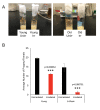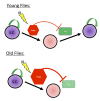Loss of foxo rescues stem cell aging in Drosophila germ line
- PMID: 28925355
- PMCID: PMC5644957
- DOI: 10.7554/eLife.27842
Loss of foxo rescues stem cell aging in Drosophila germ line
Abstract
Aging stem cells lose the capacity to properly respond to injury and regenerate their residing tissues. Here, we utilized the ability of Drosophila melanogaster germline stem cells (GSCs) to survive exposure to low doses of ionizing radiation (IR) as a model of adult stem cell injury and identified a regeneration defect in aging GSCs: while aging GSCs survive exposure to IR, they fail to reenter the cell cycle and regenerate the germline in a timely manner. Mechanistically, we identify foxo and mTOR homologue, Tor as important regulators of GSC quiescence following exposure to ionizing radiation. foxo is required for entry in quiescence, while Tor is essential for cell cycle reentry. Importantly, we further show that the lack of regeneration in aging germ line stem cells after IR can be rescued by loss of foxo.
Keywords: D. melanogaster; adult stem cells; aging; cell biology; developmental biology; foxo; germline stem cells; irradiation-induced quiescence; stem cells; tor.
Conflict of interest statement
No competing interests declared.
Figures















References
-
- Bitto A, Ito TK, Pineda VV, LeTexier NJ, Huang HZ, Sutlief E, Tung H, Vizzini N, Chen B, Smith K, Meza D, Yajima M, Beyer RP, Kerr KF, Davis DJ, Gillespie CH, Snyder JM, Treuting PM, Kaeberlein M. Transient rapamycin treatment can increase lifespan and healthspan in middle-aged mice. eLife. 2016;5:e16351. doi: 10.7554/eLife.16351. - DOI - PMC - PubMed
MeSH terms
Substances
Grants and funding
LinkOut - more resources
Full Text Sources
Other Literature Sources
Medical
Molecular Biology Databases
Research Materials
Miscellaneous

